
What material(s) do you use in your sculptures?
“I predominately use water-based clay (Armadillo’s Buffalo Wallow is my favorite) to model, although I sometimes will use oil-based clay, depending on the outcome. For the finished sculpture, it could be ceramics, bronze, or plaster, or all three.“
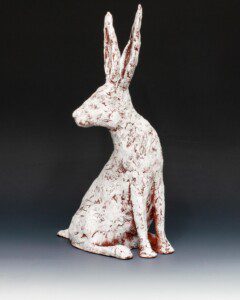
White Rabbit
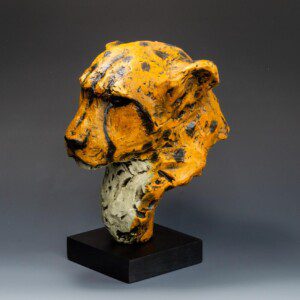
Cheetah
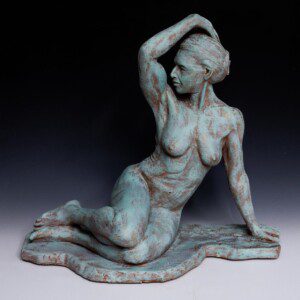
Moon Goddess
What is your primary forming method?
“My primary forming method is modeling. I use the additive and subtractive methods of forming clay to get the results I’m looking for. For larger sculptures, I build armatures utilizing (some or all) steel pipes, aluminum gauged wire, and paper. Depending on the outcome, I design the armature to fit the purpose.”
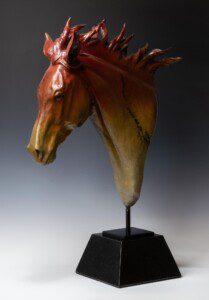
Contessa
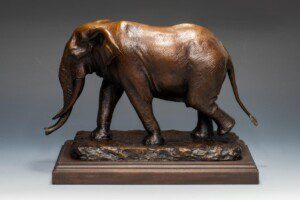
Bull Elephant
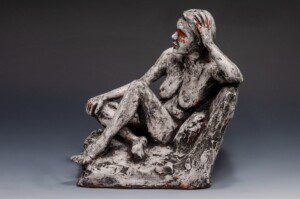
War Paint
What is your favorite surface treatment?
“My favorite surface treatment utilizes various modeling tools to create rough and smooth texture, building variations and movement on the surface of the model. I usually leave tool marks on the surface, if it works with the piece, stimulating more interest in the craftsmanship and evolution of the sculpture. For ceramics only, I use one or a combination of Amaco Velvet Underglazes, iron oxide washes, and a variety of ceramic glazes.”
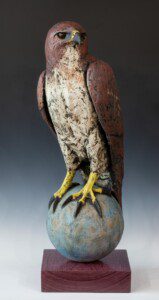
Red Tailed Hawk
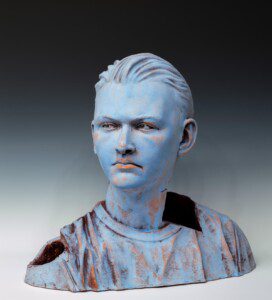
A Hard Rains a-Gonna Fall
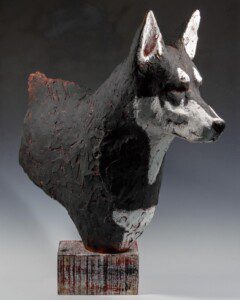
Zeus
What are your favorite Tools?
“My favorite tools are Sculpture House’s hardwood and serrated wire end, modeling tools.”
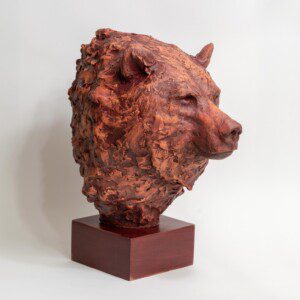
Grizzly, Ceramic
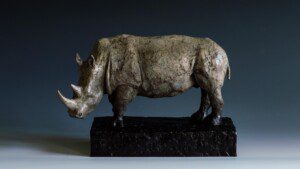
White Rhino
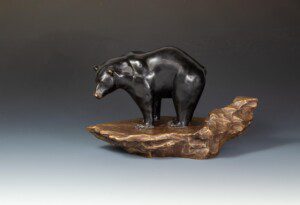
Korben
Describe your studio environment.
“My studio environment is a converted room in our house that is brightly lit with natural light from two eastern facing windows, as well as artificial shop lights hung from the ceiling. Walls are painted a peaceful light blue green (Emmy Green, after my granddaughter), with collected artwork and personal photos, hung throughout the studio. Assorted completed sculptures, studies, models, and works in progress, are placed on shelves and various unused spaces. 3 rolling worktables, 4 rolling pedestals, all homemade. Lots of various music playing out loud, for my many moods and emotions. A flat screen TV attached to the wall displays reference photos. I stand at my work, so seating is minimal except for a stool or two. My garage has a Skutt kiln and plenty of woodworking equipment and tools, miscellaneous sculpting materials such as plaster, which is too messy for the interior, that help to complete my sculpture process.“
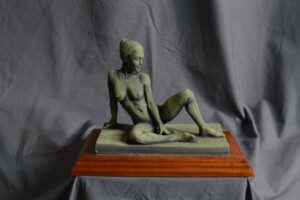
Green Goddess
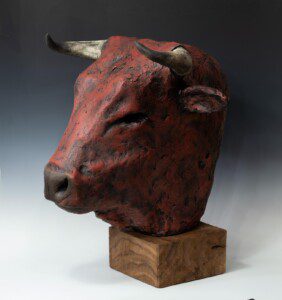
Red Bull
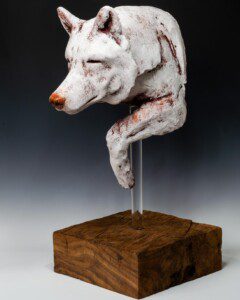
Denali
How/Where do you market and sell your artwork?
“I market my work through social media, a personal website, TSOS website, galleries, invitational art shows, and word of mouth.”
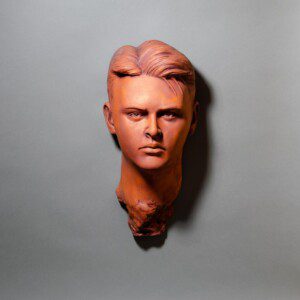
Mac, Terracotta
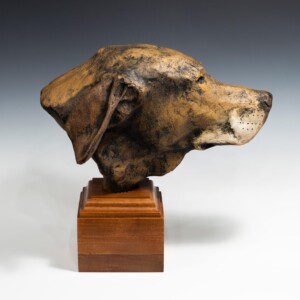
Hank
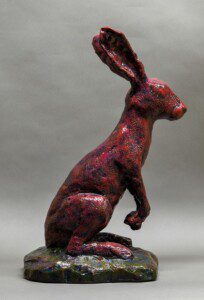
Red Rabbit
What sparks your creativity? What drives you to create?
“I can’t describe or easily analyze what sparks my creativity but definitely have a better understanding of what drives my creativity. I have always been influenced by the natural world, and as a child, modeled dinosaurs and animals for the purpose of a make-believe world I could bring to life, friends to my introverted personality. As an adult, pre-sculpting, I began to observe art and sculpture in a more mature light. I especially became influenced by American Western themed art; due to the time my father took us to Santa Fe on a family trip. This would be the first time I had been introduced to bronze figurative and wildlife art and storytelling. I was truly amazed by the extent of bronze sculptures and the work exhibited by influential artists and sculptors. Something inside me awoke and I felt a pulling towards bronze sculptures and western art. Once I began formal art education, western themed art would fade into the background, for this type of art wasn’t taught in college. I learned stone carving and foundry work, which both helped me grow as a sculptor. It was in college that I learned to create from my emotions, representing love, hate, anger, peace, and childhood traumas, giving life and meaning to sculptures, represented both figuratively and abstractly. I still have 6 bronze boxes of various sizes, created at the university foundry, with spikes protecting the interior, various sizes and patinas, all representing my heart, a vision and historical replica of what and how I was feeling during that period. I never want to go back to that time in my life and keep them around as such a reminder of my past. I continue creating from personal emotions. Art has become therapy. I’ve learned to be vulnerable and expose my feelings through a visual form of communication. The last six years, I have focused on figures, portraits, and animals, in ceramics and bronze. Animals come easy for me, a childhood subject I still embrace. Figures and portraits, I’m passionate about working from life. The variety of animals I’ve sculpted, whether for commissions or shows or personal therapy, have ranged from cats, dogs, horses, to wild animals such as rhinos, cheetahs, elephants, and especially owls (my mom’s favorite). When possible, studying animals from life is extremely important before I begin sculpting, and I end up visiting the subject, taking countless pictures, and sketch compositions. My intentions are not to make an exact replica of the subject, but to breathe life into the clay and create a likeness that conveys a sense of my emotions and personality. Many of my subjects become self-portraits. Others represent the subject’s personality and movement and gestures as a moment I’ve etched in my brain. I share the same passion with figure and portrait sculptures as well, studying from life when possible. I know working from life is key to my growth as an artist and sculptor, and this in essence, has been a spark for my creativity, which continues to drive me to create. As I keep growing as an artist, I am searching for meaning and compositions within my work, creating emotional stories and poetry. Life itself is enough spark for creativity and a drive to create, right?”
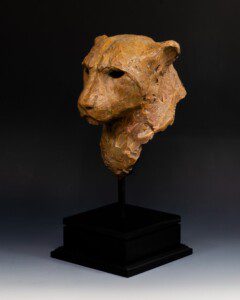
Cheetah 2
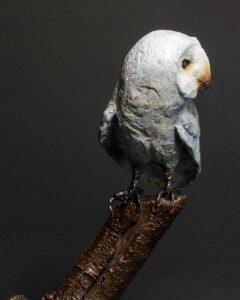
Little Barn Owl
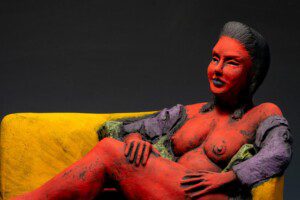
Little Devil – Closeup
Did you come to sculpture from a different career? Tell us about your journey to becoming a sculptor.
“My sculpting career has come to present from many paths and passions, just as my creativity as an artist. I didn’t pursue art or sculpting until I was in my early twenties, never really giving it much thought and only playing around with art as a kid and teenager. After high school, I spent some time in and out of college, obtaining a BFA at the age of 26, mainly because I wasn’t sure of what I wanted to study. Starting at the age of 18 and intermittent periods outside of college, I worked as a framing carpenter. Around the age of 24, after taking a few art classes at the local community college, I decided to apply and was accepted into the sculpting program at the University of GA. My studies were focused on foundry/bronze casting and stone carving, and this is when I fell in love with sculpting and the process. After college, I had no clue what it meant to be an artist or sculptor and make a living as such, so I went back to what was familiar and continued working as a framing carpenter, eventually a trim carpenter, and continued my career as a remodeling contractor. While a remodeling contractor, I designed and built cabinets, along with expanding my career in fine woodworking, stuccoing, plastering, tile work, plumbing, electric, and almost all phases of construction. I have always loved designing projects and working with my hands, to see the end results. It can also be a bit linear and monotonous at times, and I always tried to incorporate my artistic and creative side to projects. I never gave up sculpting. I would take evening figure study classes in cities we resided in and quickly learned I loved working from life and figure sculpting, working with clay, modeling tools, and having the vision to see things from an artist’s perspective. I would receive positive feedback on my work, and feel, again, this was a path I should pursue. I am also aware of my spatial sense and problem solving and will always find a need to create three dimension-ally. Presently, all that I have experienced from my past has been an integral part of my art career and I will continue to push myself as a sculptor, challenging myself with each new piece I create.”
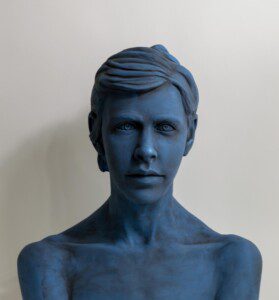
Mercer
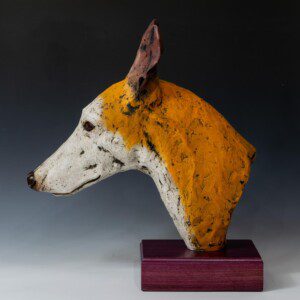
Apocalypse
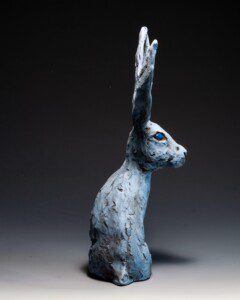
Blue Rabbit
How have you have taken your experience as a well-established maker in the field and passed that knowledge along to other artists?
“Passing knowledge as a well-established maker is something I’m not very comfortable with. I feel a bit like I have imposter syndrome, especially lacking confidence in my abilities as an artist, when there are so many more artists and sculptors who have dedicated their lives to the trade. My background in the arts has been an experimental, painful, happy, emotional, and loving journey to fulfill what’s absent in my heart. Art and sculpting have become a passion and a purpose for me, and it can be a lonely road, but if you believe in yourself, you believe in your talents, and you can express yourself emotionally, you’re on your way to being the artist you yearn to be. I rarely speak of sales, commissions, or gallery representation to other artists, because it’s all relative to how a world that doesn’t understand an artist can relate in a superficial way. I want my art to have a purpose, to engage emotions, have patrons stop and be amazed I created that piece. I can remember almost every piece I’ve created, the purpose, inspiration, the crazy deep emotions, the relationship between I and the work, and that to me is what life is about, poetry and art coming together. Everyone has the potential to be an artist. I have a friend who would draw me stick figures and laugh about it, yet, as simple as they were, they always told a story. I think about that as an artist and accept that I’m not alone, just different in how I express myself. My knowledge would be to keep creating with the tools you have, educate yourself, take classes, draw, recognize your strengths, hone your skills, and know that you will make millions of mistakes before you find the solutions.”
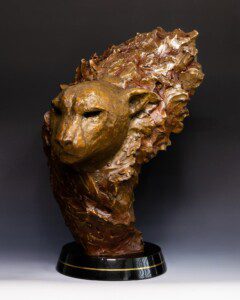
Portrait of Confidence
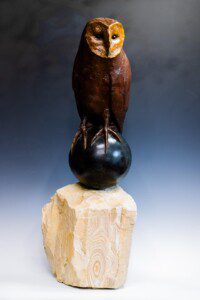
Messenger Edition 1
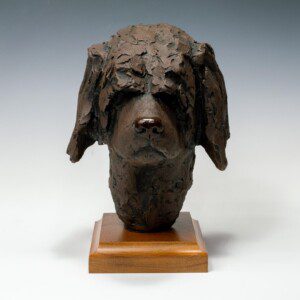
Morena
What’s the best advice you’ve been given by a fellow maker, mentor, or teacher?
“It’s just clay. If you don’t make it right the first time, you can redo it, over and over and over.”
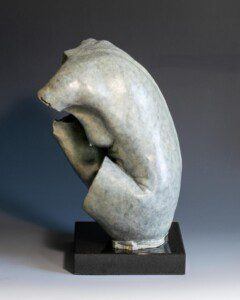
The Light within Us
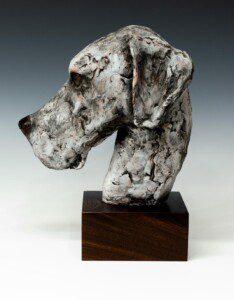
Myers
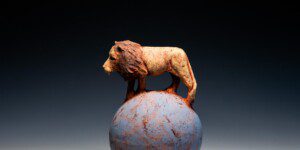
Little Lion – close up
TSOS Member Profile: Matt Donner
Website: https://www.mdonnercollections.com/
Instagram: @mattdonnersculptures
Facebook: Matt Donner, Sculptor and Ceramic Artist
Bio:
Matt Donner is a nationally acclaimed, award winning figurative, portrait, and animal sculptor creating representational art in ceramics and limited-edition bronzes. His artwork has been exhibited in numerous juried shows and is represented by several fine art galleries. Donner has created a prolific following solely from commissions and personal collections. He is passionate about conveying his subjects’ feelings, movements, and souls. Over the years, he has consistently honed his skills, relying on life studies, artist’s influence, and zest for learning to create a style which communicates movement, gestures, and beauty influenced by all living beings. Donner’s intention as an artist is to express a deeper love and understanding of his subjects, impressionistic of one’s own emotions and personal journeys.
Matt Donner was born and raised in Macon, GA. and graduated from the University of Georgia with a BFA in Sculpting. He is currently the president of the Texas Society of Sculptors. He and his family reside in Cedar Park, TX.
.
